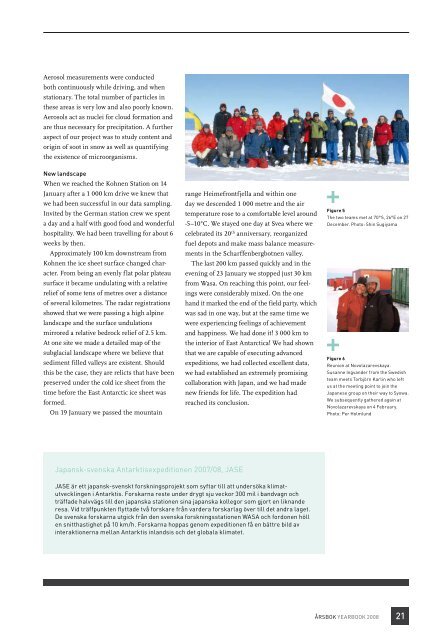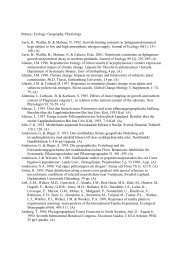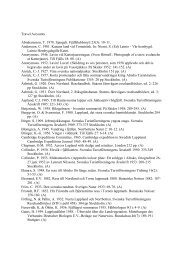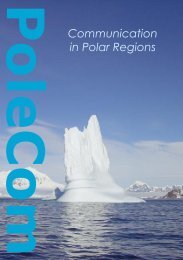Ladda ner årsbok 2008 (6,5 MB) - Polarforskningssekretariatet
Ladda ner årsbok 2008 (6,5 MB) - Polarforskningssekretariatet
Ladda ner årsbok 2008 (6,5 MB) - Polarforskningssekretariatet
Create successful ePaper yourself
Turn your PDF publications into a flip-book with our unique Google optimized e-Paper software.
Aerosol measurements were conducted<br />
both continuously while driving, and when<br />
stationary. The total number of particles in<br />
these areas is very low and also poorly known.<br />
Aerosols act as nuclei for cloud formation and<br />
are thus necessary for precipitation. A further<br />
aspect of our project was to study content and<br />
origin of soot in snow as well as quantifying<br />
the existence of microorganisms.<br />
New landscape<br />
When we reached the Kohnen Station on 14<br />
January after a 1 000 km drive we knew that<br />
we had been successful in our data sampling.<br />
Invited by the German station crew we spent<br />
a day and a half with good food and wonderful<br />
hospitality. We had been travelling for about 6<br />
weeks by then.<br />
Approximately 100 km downstream from<br />
Kohnen the ice sheet surface changed character.<br />
From being an evenly flat polar plateau<br />
surface it became undulating with a relative<br />
relief of some tens of metres over a distance<br />
of several kilometres. The radar registrations<br />
showed that we were passing a high alpine<br />
landscape and the surface undulations<br />
mirrored a relative bedrock relief of 2.5 km.<br />
At one site we made a detailed map of the<br />
subglacial landscape where we believe that<br />
sediment filled valleys are existent. Should<br />
this be the case, they are relicts that have been<br />
preserved under the cold ice sheet from the<br />
time before the East Antarctic ice sheet was<br />
formed.<br />
On 19 January we passed the mountain<br />
range Heimefrontfjella and within one<br />
Japansk-svenska Antarktisexpeditionen 2007/08, JASE<br />
day we descended 1 000 metre and the air<br />
temperature rose to a comfortable level around<br />
-5–10°C. We stayed one day at Svea where we<br />
celebrated its 20th anniversary, reorganized<br />
fuel depots and make mass balance measurements<br />
in the Scharffenbergbotnen valley.<br />
The last 200 km passed quickly and in the<br />
evening of 23 January we stopped just 30 km<br />
from Wasa. On reaching this point, our feelings<br />
were considerably mixed. On the one<br />
hand it marked the end of the field party, which<br />
was sad in one way, but at the same time we<br />
were experiencing feelings of achievement<br />
and happiness. We had done it! 3 000 km to<br />
the interior of East Antarctica! We had shown<br />
that we are capable of executing advanced<br />
expeditions, we had collected excellent data,<br />
we had established an extremely promising<br />
collaboration with Japan, and we had made<br />
new friends for life. The expedition had<br />
reached its conclusion.<br />
JASE är ett japansk-svenskt forskningsprojekt som syftar till att undersöka klimatutvecklingen<br />
i Antarktis. Forskarna reste under drygt sju veckor 300 mil i bandvagn och<br />
träffade halvvägs till den japanska stationen sina japanska kollegor som gjort en liknande<br />
resa. Vid träffpunkten flyttade två forskare från vardera forskarlag över till det andra laget.<br />
De svenska forskarna utgick från den svenska forskningsstationen WASA och fordonen höll<br />
en snitthastighet på 10 km/h. Forskarna hoppas genom expeditionen få en bättre bild av<br />
interaktio<strong>ner</strong>na mellan Antarktis inlandsis och det globala klimatet.<br />
Figure 5<br />
The two teams met at 70°S, 26°E on 27<br />
December. Photo: Shin Sugiyama<br />
Figure 6<br />
Reunion at Novolazarevskaya.<br />
Susanne Ingvander from the Swedish<br />
team meets Torbjörn Karlin who left<br />
us at the meeting point to join the<br />
Japanese group on their way to Syowa.<br />
We subsequently gathered again at<br />
Novolazarevskaya on 4 February.<br />
Photo: Per Holmlund<br />
åRSBoK YEARBooK <strong>2008</strong><br />
21








